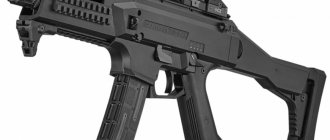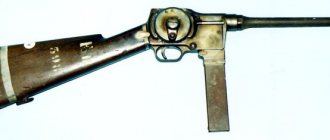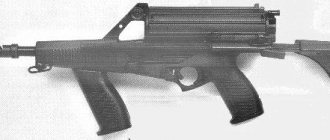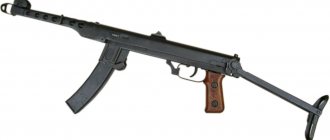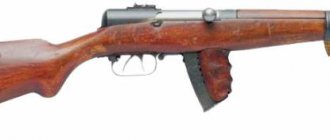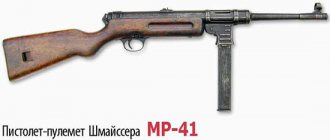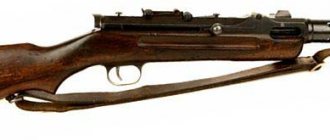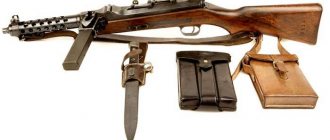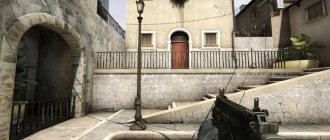Not to be confused with Skorpion or scorpio.
Pistol type caliber carbine Submachine gun (A1)
| Scorpio EVO 3 | |
| Selective fire option (A1) | |
| Type | Pistol caliber, carbine Submachine gun (A1) |
| Place of origin | Czech |
| Service history | |
| In service | 2009–present |
| Used | See Users |
| Production history | |
| Manufacturer | Česká zbrojovka Uherský Brod |
| Options | Evo 3 S1 (civilian semi-automatic version) |
| Characteristics | |
| Weight | 2.77 kg (6.10 lb) with full magazine |
| Length | Stock 670 mm (26.37 in) extended, stock 410 mm (16.14 in) folded |
| Barrel length | 196 mm (7.71 in) pistol carbine, 412 mm (16.2 in) rifle |
| Width | 60 mm (2.36 in) |
| Height | 262 mm (10.31 in) |
| Cartridge | 9 × 19 mm Parabellum / 9 × 21 mm |
| Action | Recoil |
| Rate of fire | 1150 rounds/min |
| starting speed | 370 m/s |
| Feeding system | Detachable box magazine for 10, 20, 30 rounds |
| Attractions | Picatinny rails for optics, spare sights |
Scorpio EVO 3
is a 9 mm carbine produced by Ceska Zbrojovka Uherský Brod, the select-fire variant is designated as
A1
being a submachine gun and the semi-automatic variant is designated as
S1
. The EVO 3 designation means that this firearm is the third generation of the CZ line of small submachine guns started by Škorpion vz. 61, which is not mechanically connected.
Description
The Scorpion EVO version was created back in 2001, but this was the very beginning of development. People were able to “touch” this model only in 2009 after many years of efforts by a group of enthusiasts.
The first prototype immediately interested many military personnel, but there was not enough funding for its implementation. The developers had to spend a lot of time creating weapons that meet all standards. Only after this did potential investors begin to take an interest in them.
This happened due to the need to quickly replace the outdated Scorpion software. Over the years, the creators have made attempts to release something worthwhile, but they did not succeed right away. After they became interested in this project, they made the world-famous Scorpion EVO.
The designers finalized all their prototypes, resulting in the third generation of PP.
This model was the first to be equipped with automatic firing.
Links[edit]
- https://world.guns.ru/smg/chex/skorpion-evo-iii-e.html
- "CZ SCORPION EVO 3 A1 - Ceska zbrojovka" . Archived from the original on July 5, 2012. Retrieved June 28, 2012.
- "CZ Scorpion EVO 3 S1 carbine". cz-usa.com
. Retrieved October 19, 2022. - https://www.thefirearmblog.com/blog/2017/06/07/potd-cz-scorpion-afghanistan/
- https://www.argentina.gob.ar/noticias/el-ministerio-de-seguridad-recibio-armas-y-chalecos-antibalas-hallados-en-la-afi
- T-55AM1 [@ShepherdClavis] (November 1, 2022). “Some new disturbing photos from the Cambodian National Police (CNP), we see that many of their police are now armed with CZ Scorpion Evo 3A1 assault rifles, as well as equipped with MICH helmets and LBT 6094 plate holders t.co/Vq4BXZoAgl” (Tweet) . Retrieved January 12, 2022 - via Twitter.
- T-55AM1 [@ShepherdClavis] (July 3, 2022). “The GRK line uses the LG4 (left photo) and CZ Scorpion EVO 3 A1 (right photo) multi-barrel grenade launchers. T.co/vyTDWJelil" (tweet) . Retrieved January 12, 2022 - via Twitter.
- "Czech booty doda Egyptian police 50 tisic pistol". typen.cz
. Retrieved May 24, 2013. - “Poliisin asearsenaali uusiksi - konepistoolit ja kiväärit menevät vaihtoon, mahdollisesti myös pistoolit.” Yle. October 7, 2018. Retrieved October 7, 2022.
- https://is.ge/images/File/wliuri-angarishi-2017-Geo.pdf [ permanent dead link
] - https://www.flickr.com/photos//48729738577/in/photostream/
- "Új géppisztoly csapatpróbája" .
- ↑
Wilk, Remigiusz (December 20, 2022).
"Hungarian Defense Forces Receive CZ BREN 2 Rifles". IHS Jane 360
. Warsaw. Archived from the original on December 20, 2022. Retrieved December 20, 2022. - "Latihan Pasukan Husus TNI di Halim dan Chilangkap". Retrieved July 19, 2014.
- "PDRM guna submesingan baharu keluaran Republik Czech". COSMO. January 24, 2015. Archived from the original on January 24, 2015. Retrieved January 24, 2015.
- MaxDefense Philippines
- https://specijalne-jedinice.com/Oprema/Automati/Scorpion-EVO-3-A1.html#sthash.zt0YOSpF.dpbs
- "Česká zbrojovka demonstrates products in Thailand". typen.cz
. Retrieved May 24, 2013. - "Những vũ khí" khủng "của đội tuyển bắn súng quân dụng Việt Nam" . Sokha
.
Design
The designers have developed lightweight individual automatic weapons. The Scorpion EVO automatic is built on the recoil principle of a massive bolt. To the right of the bolt is a notch that becomes narrower towards the end. This is done to allow the shutter to be chambered manually.
The technique of firing shots from a closed bolt makes shooting a mark. When the ammunition supply is exhausted, the bolt will be in the rear position. To remove it you need to press a special lever. It is located on the left near the trigger guard. The cocking handle can be moved to the other side, since it is made separately.
The trigger mechanism is divided into the following modes:
- Burst (3 shots).
- Single shot.
- Uninterrupted.
To change one of the modes, you need to rearrange the translator - fuse. Make it more comfortable with the thumb on your shooting hand.
Users[edit]
Select fire switch on option A1
| This section requires additional links for verification . |
- Afghanistan: Used by ANA commandos. [4]
- Argentina: Federal law enforcement agencies, [5] Tucuman police, Buenos Aires police, San Juan police.
- Albania: National Guard
- Bolivia: Law enforcement in Bolivia [ citation needed
] - Cambodia: Cambodian National Police and Royal Gendarmerie of Cambodia. [6] [7]
- Czech Republic: Armed Forces, Police
- Dominican Republic
- Egypt: law enforcement [8]
- Finland: Finnish Police [9]
- Georgia: Financial police [10] [11]
- Honduras [ link needed
] - Hungary: Hungarian Police, [12] Hungarian Defense Forces [13]
- Indonesia: Kostrad [14]
- Kenya: Kenya Police Service
- Malaysia: Royal Malaysian Police, [15] Malaysian Maritime Law Enforcement Department and Royal Malaysian Customs Department.
- Malta: Law enforcement in Malta
- Panama: Institutional Protection Service (SPI), National Border Service (SENAFRONT) and National Aviation Service (SENAN).
- Paraguay [ link needed
] - Philippines: Philippine Coast Guard - Special Operations Group, Philippine National Police - Special Forces [16]
- Poland: special forces
- Serbia: special forces
- Sri Lanka: special forces [17]
- Rwanda: Used by Rwandan peacekeepers in the Central African Republic. [ citation needed
] - Sudan: Law enforcement in Sudan
- Thailand: Royal Thai Police [18]
- Tunisia: Presidential Guard
- Vietnam: People's Anti-Narcotics Public Security Unit (Bureau C47), Army Rifle Team [19]
- Republic of Moldova: Police and special forces
- United States: Tennessee Drug Task Force
Performance characteristics
To fully understand the power of the Scorpion EVO, you need to understand all the parameters it has. Here are the criteria to consider:
- 9 by 19 millimeters Luger caliber;
- Weighs 2.895 kg with equipment (magazine with cartridges, belt, sight) and 2.45 kg without it;
- Sighting line 240 mm;
- An empty magazine has a mass of 0.1 kg, and a loaded one - 0.445 kilograms;
- The magazine holds 20, 30 rounds;
- Can fire 600 times without breaks;
- The rate of shots is 1150 per minute;
- 670 mm length of the entire weapon with the butt folded down (410 mm with the butt folded);
- 196 millimeters in height without a sight, but with a magazine;
- Inertial type of barrel bore locking;
- 60 mm wide;
- 6 grooves;
- The bullet flies at a speed of 370 m/s.
"Scorpio EVO 3": continuation of the legend
Submachine gun vz. 61 "Scorpion" became perhaps the most innovative product of the Czech defense industry. For the first time, an ultra-compact submachine gun was created and launched into mass production, occupying an intermediate position between a pistol and a submachine gun. Thanks to its size and the ability to carry it concealed, the Scorpion has gained popularity among intelligence agencies and covert operations forces, rightfully becoming one of the weapon legends of the past century. At the end of the 90s, the Scorpion trademark was officially registered by the CZ company from the city of Usherski Brod, and the legendary name was assigned to a new model of compact automatic weapon. But the third generation Scorpio is not a modern remake of the early 60s model.
The “grandfather” of the modern “Scorpion”, the legendary Scorpion vz. 61
The main problem of the ’61 Scorpion was its relatively low-power ammunition, the 7.65 x 17 mm Browning cartridge. Therefore, it is not surprising that over time a number of variants of the submachine gun appeared in other calibers (9 x 18 mm PM, 9 x 17 mm Short, 9 x 19 mm Luger). The most successful of them was a slightly heavier and larger version of the CZ Scorpion 9 x 19, released in small quantities in the second half of the 90s. An even more radical modernization option was the CZ 868 model, equipped with a plastic butt, front handle, optional silencer and brackets for mounting modern optics and tactical accessories. With this sample, CZ in the period from 2005 to 2006 tried to become a participant in the program to create advanced infantry weapons AIWS (Advanced Infantry Weapons Systems). But the modernized CZ 868, in fact, was transformed into a carbine chambered for a pistol cartridge and did not have any significant advantages over existing models. Therefore, it became the swan song of the second generation Scorpions. At the same time, along with the failure with the CZ 868, Czech designers came to the understanding that it was impossible to achieve positive results by resuscitating a model that was almost half a century old. The tactical and technical requirements for weapons, the materials and coatings used have changed significantly, and new and more advanced technological processes have appeared. The manufacturing technology of the old Scorpio, which was far behind the modern level, caused a lot of criticism from production workers. There was only one way out - the development of a fundamentally new model was required.
Third birth
The idea of a new PP to replace the Scorpion was relevant not only in the Czech Republic, but also in neighboring Slovakia. In 2001, a group of enthusiasts from the city of Trencin decided to begin developing a new model of their own design, giving it the name LAUGO LTG-1. The name LAUGO comes from the abbreviated name of the city of Trencin in Latin - Laugaricio, and the abbreviation LTG-1 - from the first letters of the last names of the developers: Jan Lucansky, Petr Tverdym and František Gasparik. By the way, Jan Luchansky is a former military specialist who took part in the war in the Balkans and has unique knowledge in the field of small arms. During the war on the territory of the former Yugoslavia, he had the opportunity to become closely acquainted with, compare and test in shooting not only all modern NATO infantry weapons, but many weapons from the former Yugoslavia and the Warsaw Pact countries, as well as weapons manufactured in the Balkans in a homemade or semi-handicraft way ( for example, PP Agram-2000, Šokac P1, Zagi M91 or ERO). To this list we must add weapons from the Second World War, mostly of German origin, which are still in circulation in this hot spot of Europe.
9 mm submachine gun CZ Scorpion EVO 3 A1 (left view)
Already at the stage of development work, the LAUGO submachine gun attracted the attention of experts with its originality and simplicity of the device. At the same time, the initiative group had neither the financial nor technical capabilities to continue the project on their own. Therefore, Slovak designers were actively looking for investors who could support or take over the development of PP. So in 2004, the LAUGO submachine gun first came to the attention of CZ specialists, but the prototype that existed at that time did not fully satisfy the requirements that a model developed for the armed forces must meet. Refinement of the design was required. Nevertheless, the interest from the Czech Zbroevka was a good incentive for Slovak designers to speed up work on the prototype and modify it to meet the requirements. During this period, the work was temporarily taken under the wing of the Slovak holding ZVS from the city of Dubnica nad Vahom, the heir to one of the famous arms factories, today known as the manufacturer of small arms and artillery ammunition and Slavia air rifles. He produced a prototype of the PP under the designation LAUGO M6 and presented it at the IDET-2005 arms exhibition in Brno. It was intended to produce PP for both the army (standard version M6-A, short version M6-K and silencer version M6-SD) and for the civilian market (M6-C1 carbine and shortened M6-C2 carbine). Finally, in January 2007, a contract was signed between the LAUGO development group and the CZ company. By this time, the project for the new PP was almost two-thirds ready and Česká Zbroevka took over some of the work, such as the development of plastic magazines, a trigger with a fixed queue length, as well as a variant chambered for the .40 S&W cartridge. In addition, LAUGO's design and development engineers became full-time employees of CZ. In particular, Jan Luchansky became responsible for fine-tuning the PP, ergonomics and developing a new stock. Czech designer CZ Jaroslav Červik took responsibility for construction materials, development of design and technological documentation.
9-mm submachine gun CZ Scorpion EVO 3 A1 (right view)
Representatives of the army and police also took part in the creation of the new Scorpio. The company from Ushersky Brod has long established a tradition of demonstrating prototypes to representatives of potential customers even at the development stage. CZ was very attentive to the critical comments and wishes received during such meetings. For the most part, they concerned the ease of handling and ergonomics of the weapon.
The first presentation of the new weapon took place in May 2009 at the IDET-2009 exhibition. The development of the PP was fully completed in the second half of the same year, after which tests began to test the weapon for compliance with Western military standards. At this stage, the sample was given today's official designation CZ Scorpion EVO 3 A1. The abbreviation EVO 3 in the designation of the weapon indicates that it belongs to the third generation of submachine guns called “Scorpio”, A1 indicates that this is the first modification with automatic (“A”) fire mode. A self-loading version with the ability to fire only a single fire, developed for the civilian market, is designated by the letter "S".
Design
Scorpion EVO 3 A1 is a lightweight automatic individual weapon chambered for 9 x 19 mm Luger cartridge. Its automation is based on the principle of using the recoil of a heavy, massive bolt. On the right side of the bolt there is a special recess that serves for manual chambering of the bolt in case the bolt does not reach the forward position and the weapon is heavily soiled. Shooting is carried out from a closed bolt, which has a beneficial effect on shooting accuracy. After all the cartridges in the magazine are used up, the bolt remains in the rear position; it is removed from the bolt stop by pressing the lever located on the left side of the weapon above the trigger guard. The cocking handle is made separately from the bolt and can therefore be moved to the other side of the weapon.
The receiver, which connects all the most important components of the weapon, consists of two halves and is made of high-strength polymer. In its front part there is a sleeve into which the barrel is screwed. In addition to the receiver, the trigger mechanism body, barrel casing, pistol grip and butt are made from polymer materials. Such widespread use of plastics has made it possible to make the weapon very light: the weight of the Scorpion without cartridges is only 2770 g, approximately the same as the German MP5 PP in the version with a permanent stock (MP5 A2 or A4), which is considered the standard in its class. At the same time, the widespread use of plastics does not affect the combat properties of the weapon: tests have shown that even after using up 20 magazines, there is no overheating of the plastic parts of the weapon and it can be fired without gloves. Contrary to the widespread prejudice about the low durability of “plastic” weapons, the Czech PP showed a very decent result during survivability tests, remaining operational after 35,000 shots fired in conditions difficult for the weapon to operate (dusty, rainy, at a temperature of -50 ° C etc.)
In total, the PP is equipped with five Picatinny rails according to the STD-MIL-1913 standard: one of them is integrated with the upper part of the receiver, and the other four are located on each side of the plastic forend. In the standard version, a mechanical sight consisting of an adjustable front sight and a diopter rear sight is installed on the top Picatinny mounting rail.
The new “Scorpion” uses sighting devices from the Italian company LPA as a standard sight: a fiberglass front sight and a diopter rear sight of the “Ghost-Ring” type.
The trigger mechanism has three firing modes: single, bursts of 3 shots and continuous. Changing fire modes is carried out by a double-sided flag switch-fuse located in the upper part of the handle and conveniently controlled by the thumb of the shooting hand. Next to the safety switch there is a horizontal pictogram that helps determine the set fire mode. In addition to the manual safety, the trigger is equipped with an automatic safety to block the firing pin. The PP trigger mechanism is mounted in a detachable housing, which greatly facilitates its repair and maintenance. In addition, the upper part of the trigger body serves as a guide for the bolt. This original solution made it possible to simplify the design of the receiver and make partial disassembly of the weapon very simple and record-breakingly fast.
To partially disassemble the new Scorpio, you need to unload the weapon, separate the magazine and pull back the cocking handle. After this, the front axis of the trigger housing is knocked out and the bolt with a return mechanism is removed into the hole formed below. By the way, this design solution of the Czechoslovak development team is protected by a patent.
The PP is fed from double-row magazines with a capacity of 30 or 20 rounds. They are made of plastic and have a transparent body, allowing you to easily monitor the filling level and ammunition consumption.
The plastic buttstock is adjustable in length and equipped with a ribbed butt pad.
The PP plastic stock folds onto the right side of the receiver. At the same time, the weapon does not lose its ability to fire. If such a need arises, the butt can be completely separated from the weapon. In its design, the butt is very similar to the butt of the Belgian FN SCAR assault rifle, which served as the prototype for the CZ805 BREN rifle. A special feature of the stock is its telescopic design, which allows it to be adjusted in length. The new “Scorpio” can be changed in the horizontal direction and the position of the pistol grip. The ability to adjust in accordance with the individual characteristics of the shooter was not put forward in the TTZ by any of the potential customers, however, thanks to this initiative of the designers, the weapon has excellent ergonomics and, with a quick application, is immediately aimed at the target. The pistol grip of the military version of the A1 differs from the grip of the civilian model S1: the latter has a smaller volume and does not allow mounting a trigger with automatic firing modes from the combat version. Therefore, converting the civilian version into an automatic weapon is excluded.
The horizontal position of the pistol grip can be changed according to the individual characteristics of the shooter
The PP can be used both with a standard “two-point” sling with two swivels attached, and with a “three-point” sling, which allows you to carry the weapon behind your back “Alpine style”, like biathletes. Other included accessories for the third Scorpion include a silencer, laser sight, tactical flashlights with mounting devices, additional handles, and red dot sights.
Of particular note is the simplicity of the design of the Czech submachine gun, consisting of more than 90 parts. The very high rate of fire is also striking, equal to 1150 rounds per minute and allowing you to discharge a 30-round magazine within 1.6 seconds. However, the weapon is well controlled even when firing continuously in long bursts. The credit here goes to the excellent shock absorption of the bolt in the rearmost position, although the plastic buffer device used in the PP looks very modest. Most likely, the lion's share of the impact energy is absorbed by the plastic receiver - this effect is well known in pistols with a polymer frame, which have a noticeably “softer” recoil compared to their all-metal counterparts.
Application
Initially, it was believed that the third generation Scorpio was an initiative development of the company, intended primarily for export. CZ's reputation and legendary name could well be the key to the success of the Scorpion EVO 3 A1 on the international arms market. However, when an order from the Czech Ministry of Defense followed for a new submachine gun, it came as a surprise even to military experts. The Czech Ministry of Defense entered into a contract in the spring of 2010 for the supply of 572 Scorpion EVO 3 A1 SMGs as a personal self-defense weapon to equip the guards of Prague Castle. The contract provides, in addition to the purchase of the weapon itself, the supply of accessories and ammunition for it. The Prague Castle Guard Brigade is an elite unit of the Czech army, which, in addition to representative functions, performs the tasks of protecting the residence of the President of the Czech Republic and his guests.
In 2012, a civilian version of the CZ Scorpion EVO 3 A1 submachine gun was introduced, called the CZ Scorpion EVO 3 S1 pistol-carbine. It is intended for professional and semi-professional training of representatives of law enforcement agencies, private security guards, self-defense, IPSC athletes or just amateur shooters. Magazine capacity 5, 10, 15 or 20 rounds. Interestingly, one of the Danish companies has already released an Airsoft version of the software.
In addition, representatives of the company stated that the new Scorpions are already being used by Czech army special forces units. This relatively small, but fundamentally important success caused a surge of interest in the new PP from a variety of security agencies. For example, according to unofficial but reliable information, the new Scorpion has already been seen in the hands of soldiers from one of the special forces of the Czech police. The listed facts certainly give Czech gunsmiths a reason for optimism, but let’s not get ahead of the curve. As they say in the Czech Republic, you should not praise the day until the evening. And yet two important conclusions can be drawn with absolute certainty.
Firstly, the development and adoption of such models as the CZ 805 BREN assault rifle (see "Brother" No. 10 of 2012) and the Scorpion EVO 3 A1 submachine gun showed that the Czech arms industry had overcome the protracted crisis and capable of competing with the world's leading ones, it is quite capable of laying claim to the role of a submachine gun to replace the well-deserved Hecker & Koch MP5, which has become almost a standard model of a submachine gun for police and special units.
If necessary, the flame arrester can be screwed off from the muzzle of the barrel and replaced with a muzzle device for silent and flameless shooting
Secondly, the example of the Scorpion EVO 3 A1 clearly showed a tendency to prefer submachine guns of the so-called “heavy class”. Although the “light class” SMGs, to which the former Scorpions belong, the Polish PM-63 RAK, the Israeli Mini-Uzi and Micro-Uzi or the American Ingram, compare favorably with heavy SMGs in size and weight, they It has significant disadvantages, such as high ammunition consumption, insufficient stability when firing in bursts and inconvenience of holding with two hands. Heavy SMGs, to which the Scorpion EVO 3 A1 belongs, are distinguished by their higher fire efficiency and much better ergonomic characteristics. Convenience of handling weapons has acquired particular importance today, since a modern fighter, as a rule, has to shoot in protective equipment (body armor, gloves). What if it’s winter, when you’re also wearing winter clothes? In this case, ergonomics becomes a paramount factor. And one more undeniable advantage of a heavy PP: it is much easier to install modern sighting optoelectronics, such as night and day optical sights, collimators, laser pointers and tactical flashlights. Of course, there are situations when a lightweight SMG is more preferable - for example, if concealed carrying of a weapon is necessary. Therefore, the class of light PPs has the right to exist, but the niche they occupy is significantly smaller than that of the heavy class PPs. In addition, recently light SMGs have had to make room somewhat due to the emergence of a new type of small arms - PDW, as well as self-loading pistols with high-capacity magazines. In this regard, CZ hit the nail on the head by relying on heavy-duty PCBs during its proactive development. However, there are no obstacles to creating a lightweight PP based on the Scorpion EVO 3 A1, as, for example, Heckler & Koch did by releasing a shortened and lightweight version of the MP5 K based on its heavy MP5. Regardless of this, the release of the third Scorpion to the market became a notable event in the weapons world.
Performance characteristics
Weapon designation CZ Scorpion EVO 3 A1 Manufacturer Ceská zbrojovka as Ushersky Brod, Czech Republic Caliber 9 x 19 mm Luge Automatic operating principle: blowback recoil Barrel bore locking inertial Total length with the butt folded back/folded 670/410 mm Width 60/85 mm Height with magazine (without sight) 196 mm Barrel length 196 mm Number of rifling 6 Rifling pitch 250 ± 10 mm Sighting line length 240 mm Weight of weapon with loaded magazine and belt 2.895 kg Weight without magazine and belt 2.45 kg Weight of empty magazine 0.1 kg Loaded magazine weight 0.445 kg Magazine capacity 20 or 30 rounds Effective range with shoulder rest/hand rest 250/50 m Allowed number of shots without interruption 600 Muzzle velocity 370 m/s Rate of fire 1150 rds/min
